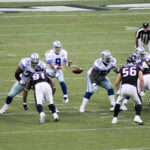My wife first noticed the lump in the spring of 2011. It was then about the size of a marble located a few centimeters below her left earlobe. It was firm but not extremely hard and quite mobile. She told me and a few other people about it and the consensus was that it was probably an enlarged lymph node. The first prompting to take some action came a few weeks later when her OBGYN noticed it during her annual. The doctor was reassuring but insistent that she get it checked out so Carrie made an appointment with a general practitioner. The GP told her it probably was a lymph node, perhaps brought on by a chronic infection of her wisdom teeth, which have never been removed. The doctor’s advice was to keep an eye on it and to come back if there was any change. A year went by during which we waited for it to go away but it did not. By the beginning of this summer it had grown to the size of a grape and though it still did not hurt, it was starting to become tender and my wife noticed it when she opened and closed her mouth.
She decided to see a different GP about it. This doctor performed a few tests to see if her facial nerve was in any way impaired (which it wasn’t) and referred Carrie to an ears, nose and throat specialist. The specialist and his physician assistant very quickly came to the realization that the lump wasn’t an enlarged lymph node–it was in the wrong place and the texture was too firm. What Carrie had, instead, was a mass on the superficial lobe of her parotid gland, the large salivary glad located just inside the cheek and jaw.
Now if the word parotid seems at all familiar to you, it should. In early May Adam Yauch-MCA, one of the original Beastie Boys-died after a three year battle with cancer of the parotid. That sad news item was the first I had heard of the gland and by a cruel twist of fate my wife was now potentially facing cancer of the same spot only a few weeks later. The doctor, however, possessed of an extremely confident and reassuring manner and armed with the facts, was not overly concerned. He knew her chances and he knew what to do about it.
There are three different pairs of salivary glands: the parotid, submandibular (below the jaw) and sublingual (below the tongue). 70 to 80% of all parotid tumors are benign, referred to as pleiomorphic adenomas. Of the malignant processes, the aggressiveness and grade of the tumor determine prognosis. Symptoms of malignancy include pain, facial weakness or paralysis and enlarged lymph nodes in the vicinity. Carrie had none of these symptoms. It was also apparent that the tumor was slow growing, mobile and in a very accessible place. All of these signs boded well.
We were informed that the standard treatment options are a fine needle aspiration and a parotidectomy. Aspiration is essentially sticking the tumor with a thin needle to collect cells and then examining those cells under a microscope. The main drawbacks are that it’s not particularly reliable, producing both false negatives and positives. Furthermore, even in the case of a benign tumor, the mass should be removed as it can still become cancerous later on and it will also continue to grow, eventually pressing on the facial nerve. A parotidectomy is the removal of the portion of the parotid gland where the mass is located as well as an additional margin of tissue to insure complete excision. The main obstacle of this surgery is that the facial nerve passes through the middle of the parotid and therefore a botched surgery can lead to facial paralysis.
The surgery is conducted by first using sensors to locate the nerve based on its electrical impulses and then mapping out all of its branches. This is actually the most time consuming part of the procedure. The next part is making a long incision, starting inside the ear, down through the tissue connecting the ear lobe to the face and then curving back along the neck. The skin is then pulled back to access the gland and remove the mass. It’s a complicated, painful and invasive surgery that is not without consequences. First, the earlobe will be permanently numb as the incision severs that nerve. The facial nerves, even with perfect preservation can also experience temporary numbness.
We scheduled the surgery for late June (it was oddly reassuring that the doctor would put the operation a month out-it wasn’t an emergency procedure). He recommended that we learn all we could in the meantime and seek out a second opinion if we liked. So we hit the internet. First we researched the doctor. This was promising as everyone we talked to about him and every review we read was glowingly positive. We then got the second opinion…which was a carbon copy of the first: parotid mass that should be removed. Finally, we settled into a month of scaring ourselves to death. From the beginning we both had different fears. My wife was most concerned about the surgery itself. She had never been under general anesthesia before. She was also, understandable, concerned about the implications for her appearance of a scar along her ear and potentially facial paralysis. She also learned about the risk of Frey’s Syndrome, a condition in which during healing the parotid gland fuses to the facial skin, producing the unusual symptom of facial sweating when a person eats.
My main concern was the possibility that my wife had cancer. I knew that the odds were good and then even if she had a malignancy, she still had an excellent prognosis and she would simply have to follow up the surgery with radiation. At the same time, odds only have so much power to comfort. The very existence of even a slight existential threat to your spouse’s life is an intolerable feeling. So I tortured myself with facts and figures for a while. Eventually, however, I did achieve an odd kind of peace of mind when I made a crucial realization. Although statistics can tell you how many people have parotid masses, how many are malignant and how many people die, what they leave out is the incredibly complex fact that each patient presents different combinations of symptoms. Most of the people with malignancy and the people who die are the people who come into the doctor with large lumps (in some cases the size of golf balls or even oranges) or who come in with facial paralysis or with compromised lymph nodes (according to what I’ve read Adam Yauch presented with enlarged lymph nodes-a very bad sign). In other words, it’s not a lottery. If you have a lump somewhere on your body and you go to the doctor early, instead of ignoring it, and you have no other symptoms of cancer then the odds are probably better than the statistics indicate that you’re going to be OK.
For the whole of that month we tried to live our lives normally. We both worked hard, saving money toward the surgery. We contacted our insurance companies and determined our level of coverage and what we would owe. We told friends and family as positively as we could about the upcoming procedure. We went out to dinner or out with friends. My wife’s best friend came to visit for a week and we had a blast showing her around scenic parts of Colorado. The time passed, albeit slowly, and then one morning we got up early, packed our bags and drove to the hospital.
We knew what to expect from our preop appointment and so we checked in, went up to surgery together and held hands as the nurses took Carrie’s vitals. We met the anesthesiologist and the doctor came in, giving a few last words of encouragement. Finally we were separated and my sister-in-law, her boyfriend and I spent three nervous hours wandering the hospital. About an hour earlier than expected (two and a half hours in) the surgery receptionist told us that Carrie was in recovery. We were taken to a small consultation room where the doctor eventually joined us. He said that the surgery went fine, there was no invasion of surrounding tissue and that the lump was almost certainly benign. About an hour after that Carrie was wheeled to her room. She had a compression bandage wrapped around her head (think Owen Wilson in The Darjeeling Limited). She was pale and her face was a bit swollen with some yellow streaks from the disinfectant.
The two days in the hospital were tough. She was prone to bouts of nausea from the general anesthetic. The morphine they tried giving at first didn’t work very well so the nurses switched her to Dilaudid. When the painkiller was on the verge of wearing off, Carrie said that her ear felt like it was going to explode. The night of the surgery, however, her mother arrived from New Jersey and it is truly amazing what a mother’s nurturing can do, even for a 31-year-old married woman. The next day it was about 102 degrees when Carrie was discharged and we drove home. She was given antibiotics and a liberal supply of Percocet as well as an anti-nausea medication. We kept a log of her medications and when they should be taken. Carrie also took arnica montana, a pellet shaped homeopathic remedy that promotes healing. We kept her about as comfortable as we could but she was often in a lot of pain. She couldn’t eat much more than mushy or watery foods as her jaw was sore. It was also incredibly hot both inside and outside of our apartment. She did begin to feel more normal, however, on the third day when we could take the bandage off and she could take a bath.
After that it was the slow business of healing: sleeping and eating, becoming more active, weaning off the Percocet, keeping the wound clean and going to the post-op appointments. On the second day we also found out that the tumor was benign, which was a tremendous relief. Now, more than three weeks later, the wound has healed up beautifully. There will be a scar but it will only be on the side of her neck and you won’t really notice it without looking for it. Her neck is still stiff and she still experiences some pain. She also can’t sleep on her left side. Her facial nerves are still tingly and numb in places and, as the doctor said, her ear lobe is completely numb. At the same time, it’s wonderful to have the ordeal over with. We are grateful that we dealt with the situation early, that we had insurance to pay for most of the expensive procedure, a doctor who executed it expertly and a loving family that helped take care of us at this difficult time.





